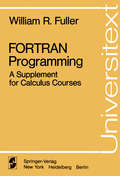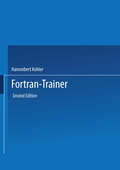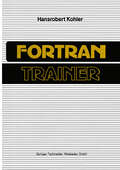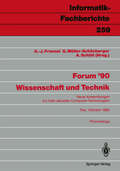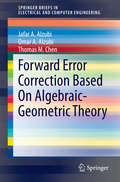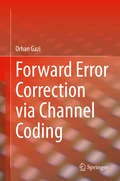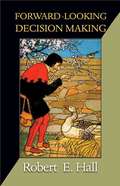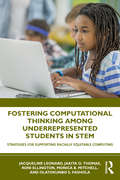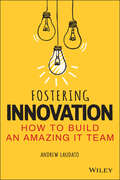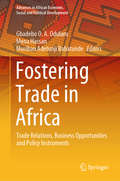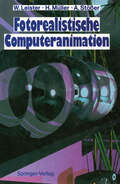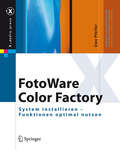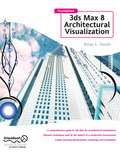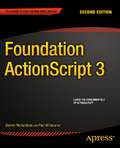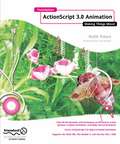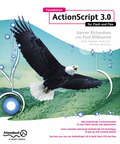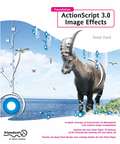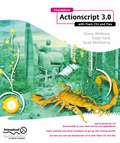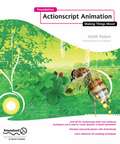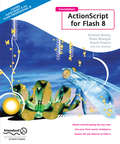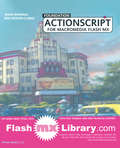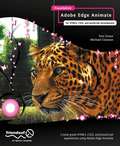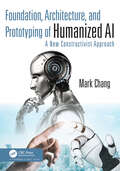- Table View
- List View
Fortran-Trainer
by Hansrobert KohlerFallunterscheidungen durchzutesten sowie eigene einfache un- sofern vorhanden - kompliziertere Literaturbeispiele durchzurech nen. Auch schon während des Studiums sollte man sich klar darüber sein, daß der spätere Auftraggeber den Programmierer zur Rechen schaft ziehen wird, wenn durch Nachlässigkeit unvollkommene und falsche Programme ihn ein unverantwortliches Mehr an Zeit und Geld kosten. Es wird in der späteren Praxis auch der Fall sein können, daß ein Fremder Ihr Programm rechnen will - oder daß Sie selbst nach einigen Monaten durch veränderte Spezifikationen Ihr eigenes Pro gramm abändern müssen - oder ein anderer Mitarbeiter sich durch Ihr Programm, das mehrere Seiten umfassen kann, hindurchkämpfen muß. Dann muß es mit wenig Zeitaufwand möglich sein, sich dieses fremd gewordene oder fremde Programm inhaltlich wie strukturell (wieder) anzueignen. Die notwendigen Informationen enthält eine Programmbeschreibung, die man beim Einordnen des Programmes in die Bibliothek als Dokumentation hinterlegt. Sie sollte minde stens enthalten: 1. Programm - Name und - Typ (HP/UP) 2. Mathematische Grundlagen 3. Eingabe / Ausgabe Daten und zugehörige Formate 4. Abweichungen von Typ - Vereinbarung (Complex, Logical usw. ) 5. Bereiche (Dimension, Common, Equivalence) 6. (ggf. ) Parameterliste 7. Programmablaufplan / Struktogramm 8. Beispiel Auch an die Anfertigung einer Programmbeschreibung sollte man sich recht frühzeitig gewöhnen. Jede sprachliche Formulierung trägt einen signifikanten Akzent, mal kurz und bündig, mal detailliert informativ, mal mit dieser, mal mit jener Wortwahl - auch bei Programmiersprachen. Diese Nuancierungen lassen sich auch in den vorliegenden Programm Vorschlägen erkennen.
FORTRAN-Trainer
by Hansrobert KohlerNur in einfachen Fällen wird dem Programmierer eine Formel vor gegeben sein, mit der er ein Tabellenwerk für unterschiedliche Vorgaben erstellen soll. Wesentlicher ist das Programmieren von Abläufen, die sich nach bestimmten Vorschriften wiederhole- wie z. B. die iterativen und rekursiven Verfahren der numerischen Mathematik. Hierzu kann man sich in gängigen Fällen bereits be kannter Algorithmen bedienen, die dem Programmierer aus Veröffent lichungen unterschiedlicher Art zur Verfügung stehen. Aber auch diese Aufgabenstellungen erfordern in der Regel nur die Beherrschung der Programmiersprache an sich, und auf dem Weg zur Beherrschung der Sprache werden derartige übungen unumgäng lich sein. Dies gilt auch für den vorliegenden FORTRAN-Trainer. Dennoch muß man sich klar darüber sein, daß die Beherrschung der Sprache zwar für manche Studiengebiete ausreicht, daß aber das Endziel erst dann erreicht ist, wenn man in das algorithmische Denken hineingewachsen ist und auch dieses anwenden kann. So kann es Aufgabenstellungen geben, in denen der vorausgehende Denkpro zeß, wie man die Programmierung anzupacken hat, wesentlich mehr Zeit beansprucht als das Programmieren selbst. Meist sind dies Probleme, die kaum Formeln beinhalten und oft unscheinbar aus sehen, dann aber in der organisatorischen Umsetzung in ein Pro gramm erhebliche Schwierigkeiten mit sich bringen können. Wie beispielsweise können Sie n Damen derart auf ein (nxn)-Schach brett setzen, daß sie sich nicht gegenseitig schlagen können? Lassen Sie doch z. B.
Forum ’90 Wissenschaft und Technik: Neue Anwendungen mit Hilfe aktueller Computer-Technologien, Trier, 8./9. Oktober 1990 Proceedings (Informatik-Fachberichte #259)
by Hans-Jürgen Friemel Gisbert Müller-Schönberger Andreas SchüttDas Europa der 90er Jahre stellt in den verschiedensten Bereichen eine Herausforderung dar, insbesondere auch in Wissenschaft und Technik. Die Träger dieses innovativen Bereiches - die Hochschulen, Forschungsinstitute und die Industrie - sind daher aufgefordert, ihren bisher gepflegten Gedankenaustausch zu verstärken. Das "Forum '90 Wissenschaft und Technik" soll ein weiterer Meilenstein auf diesem Weg sein. Wissenschaftlern und Forschern, Entwicklern und Anwendern soll die Möglichkeit geboten werden, sich über aktuelle neue Techniken und Anwendungsgebiete zu informieren und ihre Erfahrungen auszutauschen. Mit diesem Ziel möchten die Universität Trier, die Stadt Trier, der Siemens-Informationstechnik Anwenderverein e.V. (SAVE) und die Siemens AG als gemeinsame Veranstalter ein breites Vortragsprogramm anbieten. Während des zweitägigen Forums sollen sowohl Themen von allgemein wissenschaftlichem Interesse behandelt als auch spezielle Grundprinzipien, Technologien und Anwendungsgebiete in vier verschiedenen Fachgebieten vorgestellt werden: den Geisteswissenschaften, den Wirtschaftswissenschaften, den Ingenieurwissenschaften und den Naturwissenschaften.
Forward Error Correction Based On Algebraic-Geometric Theory (SpringerBriefs in Electrical and Computer Engineering)
by Jafar A. Alzubi Omar A. Alzubi Thomas M. ChenThis book covers the design, construction, and implementation of algebraic-geometric codes from Hermitian curves. Matlab simulations of algebraic-geometric codes and Reed-Solomon codes compare their bit error rate using different modulation schemes over additive white Gaussian noise channel model. Simulation results of Algebraic-geometric codes bit error rate performance using quadrature amplitude modulation (16QAM and 64QAM) are presented for the first time and shown to outperform Reed-Solomon codes at various code rates and channel models. The book proposes algebraic-geometric block turbo codes. It also presents simulation results that show an improved bit error rate performance at the cost of high system complexity due to using algebraic-geometric codes and Chase-Pyndiah’s algorithm simultaneously. The book proposes algebraic-geometric irregular block turbo codes (AG-IBTC) to reduce system complexity. Simulation results for AG-IBTCs are presented for the first time.
Forward Error Correction via Channel Coding
by Orhan GaziThis book provides a comprehensive explanation of forward error correction, which is a vital part of communication systems. The book is written in such a way to make the subject easy and understandable for the reader. The book starts with a review of linear algebra to provide a basis for the text. The author then goes on to cover linear block codes, syndrome error correction, cyclic codes, Galois fields, BCH codes, Reed Solomon codes, and convolutional codes. Examples are provided throughout the text.
Forward-Looking Decision Making: Dynamic Programming Models Applied to Health, Risk, Employment, and Financial Stability
by Robert E. HallIndividuals and families make key decisions that impact many aspects of financial stability and determine the future of the economy. These decisions involve balancing current sacrifice against future benefits. People have to decide how much to invest in health care, exercise, their diet, and insurance. They must decide how much debt to take on, and how much to save. And they make choices about jobs that determine employment and unemployment levels. Forward-Looking Decision Making is about modeling this individual or family-based decision making using an optimizing dynamic programming model. Robert Hall first reviews ideas about dynamic programs and introduces new ideas about numerical solutions and the representation of solved models as Markov processes. He surveys recent research on the parameters of preferences--the intertemporal elasticity of substitution, the Frisch elasticity of labor supply, and the Frisch cross-elasticity. He then examines dynamic programming models applied to health spending, long-term care insurance, employment, entrepreneurial risk-taking, and consumer debt. Linking theory with data and applying them to real-world problems, Forward-Looking Decision Making uses dynamic optimization programming models to shed light on individual behaviors and their economic implications.
Fostering Computational Thinking Among Underrepresented Students in STEM: Strategies for Supporting Racially Equitable Computing
by Jacqueline Leonard Jakita O. Thomas Roni Ellington Monica B. Mitchell Olatokunbo S. FasholaThis book broadly educates preservice teachers and scholars about current research on computational thinking (CT). More specifically, attention is given to computational algorithmic thinking (CAT), particularly among underrepresented K–12 student groups in STEM education. Computational algorithmic thinking (CAT)—a precursor to CT—is explored in this text as the ability to design, implement, and evaluate the application of algorithms to solve a variety of problems. Drawing on observations from research studies that focused on innovative STEM programs, including underrepresented students in rural, suburban, and urban contexts, the authors reflect on project-based learning experiences, pedagogy, and evaluation that are conducive to developing advanced computational thinking, specifically among diverse student populations. This practical text includes vignettes and visual examples to illustrate how coding, computer modeling, robotics, and drones may be used to promote CT and CAT among students in diverse classrooms.
Fostering Computational Thinking Among Underrepresented Students in STEM: Strategies for Supporting Racially Equitable Computing
by Jacqueline Leonard Jakita O. Thomas Roni Ellington Monica B. Mitchell Olatokunbo S. FasholaThis book broadly educates preservice teachers and scholars about current research on computational thinking (CT). More specifically, attention is given to computational algorithmic thinking (CAT), particularly among underrepresented K–12 student groups in STEM education. Computational algorithmic thinking (CAT)—a precursor to CT—is explored in this text as the ability to design, implement, and evaluate the application of algorithms to solve a variety of problems. Drawing on observations from research studies that focused on innovative STEM programs, including underrepresented students in rural, suburban, and urban contexts, the authors reflect on project-based learning experiences, pedagogy, and evaluation that are conducive to developing advanced computational thinking, specifically among diverse student populations. This practical text includes vignettes and visual examples to illustrate how coding, computer modeling, robotics, and drones may be used to promote CT and CAT among students in diverse classrooms.
Fostering Innovation: How to Build an Amazing IT Team
by Andrew LaudatoProven and practical strategies for leading IT teams and departments In Fostering Innovation: How to Build an Amazing IT Team, accomplished technology strategist, executive, and leader Andrew Laudato delivers an eye-opening exploration of how to design, build, staff, and run a high-performing IT department. The book is filled with universally applicable strategies and techniques that can transform any IT team into an all-star cast perfectly aligned with your organization’s objectives. Incorporating proven and practical processes throughout the narrative, the book offers useful continuous improvement concepts the reader can apply to their team, company, and professional development. Readers will also find: Foolproof ways to put people before technology Detailed discussions of perennially important topics, like the importance of uptime, how to deploy redundancy, and creating the perfect organization chart Strategies for managing and motivating the wonderfully unique individuals we refer to as "technologists." The perfect resource for newly minted Chief Information Officers and Chief Technology Officers, Fostering Innovation will also earn a place in the libraries of non-technical professionals who work closely with IT, and business leaders seeking a better understanding of how to lead an IT team.
Fostering Innovation: How to Build an Amazing IT Team
by Andrew LaudatoProven and practical strategies for leading IT teams and departments In Fostering Innovation: How to Build an Amazing IT Team, accomplished technology strategist, executive, and leader Andrew Laudato delivers an eye-opening exploration of how to design, build, staff, and run a high-performing IT department. The book is filled with universally applicable strategies and techniques that can transform any IT team into an all-star cast perfectly aligned with your organization’s objectives. Incorporating proven and practical processes throughout the narrative, the book offers useful continuous improvement concepts the reader can apply to their team, company, and professional development. Readers will also find: Foolproof ways to put people before technology Detailed discussions of perennially important topics, like the importance of uptime, how to deploy redundancy, and creating the perfect organization chart Strategies for managing and motivating the wonderfully unique individuals we refer to as "technologists." The perfect resource for newly minted Chief Information Officers and Chief Technology Officers, Fostering Innovation will also earn a place in the libraries of non-technical professionals who work closely with IT, and business leaders seeking a better understanding of how to lead an IT team.
Fostering Trade in Africa: Trade Relations, Business Opportunities and Policy Instruments (Advances in African Economic, Social and Political Development)
by Gbadebo O. A. Odularu Mena Hassan Musibau Adetunji BabatundeThis book discusses trade relations and facilitation issues at both the regional and the continental African level, highlighting the increasing business opportunities and challenges that confront Africa in the digital age. It also examines the effects of trade policies and other policy instruments on Africa’s economic development and presents workable policy measures for a more business-friendly ecosystem. Discussing various topics, including trade relations between African countries, African and international trade agreements, and trade liberalization policies, the book appeals to scholars of economics, business and management as well as professionals and policymakers interested in fostering free trade and sustainable business development in Africa.
Fotorealistische Computeranimation
by Wolfgang Leister Heinrich Müller Achim StößerDie heutige Computergraphik in ihren vielfältigen Anwendungen zeigt eine Tendenz zu Farbe und Bewegung. Die immer häufiger als Vorspann, in Werbespots, aber auch in wissenschaftlichen Visualisierungen verwendeten rechnergenerierten Animationen erzielen ihre Wirkung durch die Simulation optischer Effekte, etwa des Reflexionsverhaltens metallischer Oberflächen, und durch ausgefeilte Bewegungsabläufe bis hin zu korrektem physikalischen Verhalten. In diesem Buch werden Techniken zur Produktion derartiger fotorealistischer Computeranimationen vorgestellt und anhand des Computerfilms Occursus cum Novo demonstriert. Die Kapitel werden durch Übersichten zum Stand der Technik und Verweise auf relevante weiterführende Literatur abgeschlossen. Für potentielle Entwickler von Animationssystemen werden in diesem Buch grundlegende Verfahren und ihre effiziente Umsetzung in Algorithmen und Software dargestellt. Anwender erfahren technische Einzelheiten, die helfen können, die Wirkungsweise der eingesetzten Systeme besser zu verstehen. Das umfangreiche, überwiegend farbige Bildmaterial vermittelt auch dem nicht technisch orientierten Leser den "Stand der Kunst".
FotoWare Color Factory: System installieren - Funktionen optimal nutzen (X.media.press)
by Uwe PfeiferKostensenkung durch Automatisierung ist ein wichtiges Thema in allen Reproabteilungen. Color Factory von FotoWare leistet auf diesem Gebiet Enormes, vorausgesetzt die Software ist effizient konfiguriert. Dieses Buch hilft Anwendern, die das Produkt bereits lizensiert haben, dessen Konfiguration zu optimieren und bietet Denkanstöße für Lösungen. Interessenten von Color Factory erhalten einen Überblick über Leistungen und Einsatzmöglichkeiten. Die anschauliche Darstellung der Features ermöglicht es, die Information schnell aufzunehmen. Schwerpunkt bildet die automatisierte Bildbearbeitung, die über ein sehr hohes Einsparpotenzial verfügt.
Foundation 3ds Max 8 Architectural Visualization
by Brian L. Smith* This is the only book on the market covering 3Ds max for Architectural visualizations, one of the most common uses of 3Ds Max. * Includes quickstart tutorial sections to get the reader up and running as quickly as possible. * It will be one of the first books to come out about the new version of the product.
Foundation ActionScript 3
by Paul Milbourne Darren RichardsonActionScript 3 is a full-fledged programming language, with complete object-oriented capabilities, event handling, sound and video support, drawing capabilities, support for regular expressions, and much more.Whether you are just starting out on the road to computer programming and animation or an experienced developer who wants to learn a new language, you’ll find all you need to know in Foundation ActionScript 3. Starting with the fundamentals, you’ll learn how to add interactivity to your Flash movies by using ActionScript objects, manipulating sound and video, and harnessing the power of regular expressions and XML. The book concludes with two case studies to consolidate what you’ve learned and introduce some additional advanced techniques. You’ll gain a solid understanding of the exciting world of ActionScript 3 and see how everything fits together, so you’ll be able to build your own professional applications.The sensible layout of the book makes it easy to find information about specific techniques. It focuses on the essential skills that will enable you to get up and running quickly. With this book as your guide, you’ll be creating killer Flash applications before you know it.
Foundation Actionscript 3.0 Animation: Making Things Move!
by Keith PetersThis is the first definitive and authoritative book available on ActionScript 3 animation techniques. ActionScript animation is a very popular discipline for Flash developers to learn. The essential skill set has been learned by many Flash developers through the first edition of this book. This has now been updated to ActionScript 3, Adobe's new and improved scripting language. All of the code has been updated, and some new techniques have been added to take advantage of ActionScript 3's new features, including the display list and new event architecture. The code can be used with the Flash 9 IDE, Flex Builder 2, or the free Flex 2 SDK.
Foundation ActionScript 3.0 for Flash and Flex
by Darren Richardson Paul MilbourneActionScript 3.0, the latest version of the Flash Platform's scripting language, offers many new and powerful features. ActionScript is now a full-fledged programming language, with complete object-oriented capabilities, improved event handling, sound and video support, drawing capabilities, support for regular expressions, and much more. Whether you are a Flash designer wishing to add to your skill set or an experienced ActionScript developer who wants to get up to speed with the latest version, you'll find all you need to know in Foundation ActionScript 3.0 for Flash and Flex. Starting with the fundamentals, you'll learn how to add interactivity to your Flash movies by using ActionScript objects, manipulating sound and video, and harnessing the power of regular expressions and XML. The book concludes with two case studies to consolidate what you've learned and introduce some additional advanced techniques. You'll gain a solid understanding of the new and exciting world of ActionScript 3.0 and see how everything fits together to form complete applications, so you'll be able to build your own professional sites. The sensible layout of the book makes it easy to find information about specific techniques. It focuses on the essential skills that will enable you to get up and running quick. With this book as your guide, you'll be creating killer Flash applications before you know it.
Foundation ActionScript 3.0 Image Effects
by Gerald YardFaceFoundation ActionScript 3.0 Image Effects discusses the ins and outs of graphical manipulation through code of all the different elements available in a Flash project, from vectors to bitmaps to videos, from animated text effects to dynamic video filters. Flash 8 introduced a vast array of image features, such as blend modes and filters as well as ActionScript's powerful BitmapData object, and this book covers all those effects in their CS4 form, as well as the graphical options that are available, such as the Pixel Bender Toolkit. It also details the many possible effects that can be achieved and the associated practical applications, with a focus on strong object-oriented programming methodologies to make the code more modular and reusable across projects. Gives detailed information on all of the image manipulation abilities of Flash CS4 Covers complex technology, such as the Pixel Bender Toolkit There is no other book like it, covering the same topics in as much depth
Foundation ActionScript 3.0 with Flash CS3 and Flex
by Sean McSharry Gerald YardFace Steve WebsterThis book teaches ActionScript to both aspiring ActionScript developers and experienced ones who want to upgrade their knowledge to the new version. It details how to use ActionScript through both Flash CS2 and Flex 2 (open source ActionScript developers should also be able to make use of the book). Coverage focuses on essential real world techniques and assumes no previous ActionScript knowledge. In addition, the book features a host of practical examples; reference sections are also included at the back of the book allowing the reader to easily look up syntax.
Foundation ActionScript Animation: Making Things Move!
by Keith Peters* The only definitive and authoritative book available on ActionScript animation. * Provides for a thorough understanding of complex principles, along with practical examples. * You don't have to be an ActionScript expert to get the most out of this book. * Written by Keith Peters, author of many books, and a popular community figure.
Foundation ActionScript for Flash 8
by Kristian Besley Sham Bhangal Eric Dolecki David PowersSupports Flash 8, due later this year; will be a huge market Provides professional best practices—strong emphasis on planning, documentation, and adhering to strict and clean coding from the outset Teaches you to create dynamic, reusable rich-client web applications and services
Foundation ActionScript for Macromedia Flash MX
by Ben Renow-Clarke Sham BhangalWith the release of Flash MX, scripting in Flash moved from being a desirable asset to an essential skill in the world of web design. ActionScript is, quite simply, the center of power in Flash, and it's no surprise that most of the advances in Flash MX are script-centric.Flash is a design tool, and ActionScript can easily scare designers. This book is for anyone who has ever looked in awe at a cutting-edge Flash site, then taken a look at some code, and run in the other direction. Learning ActionScript with friends of ED will not turn you into a boring programmer, it will turn you into someone who finally has the power to achieve what they want with their web design.This book will take you from knowing nothing about ActionScript to a firm knowledge that will allow you to exercise a previously unimaginable amount of power over your flash movies. It does this with fully-0worked examples throughout, and a case study that will leave you with a cutting-edge Flash site by the end of the book.The book assumes no previous knowledge of code or ActionScript, but does assume that you know the basics of the Flash interface, and have maybe created some basic timeline-based movies with tweens and so on. (If you're totally new to Flash, then you might want to take a look at friends of ED's acclaimed Foundation Flash MX, or at the more visually-oriented Flash MX Express.)Foundation ActionScript—with the help of friends of ED Flash guru Sham Bhangal, Foundation ActionScript has been re-structured and re-written to reflect the major changes in ActionScript brought about with Flash MX. Just compare the table of contents if you don't believe us!
Foundation Adobe Edge Animate: for HTML5, CSS3, and JavaScript Development
by Tom Green Michael ClawsonFoundation Adobe Edge Animate is a project-oriented book that will walk you through the features of Edge Animate - Adobe's exciting new motion and interaction tool for web standards development. Edge Animate is an application that allows web designers and developers to make full use of many of the features of CSS3, JavaScript, and HTML5. Edge Animate enables you to animate graphics without the need to hand code everything using canvas or SVG. It exports well-formed, standards-compliant code that you can either use to create new web products, or add directly into existing projects. It also features full JavaScript and DOM manipulation, enabling you to get under the hood and create fantastic interactive experiences. Using a unique project-oriented focus you will be creating carefully developed projects designed to give you the skills and confidence necessary to undertake interactive and web design experiences aimed at devices ranging from smart phones to the TV set in your living room. Along the way you will discover how many of the tools in the Adobe Web Design CS6 collection can be fully utilized to create expressive and engaging web applications. This includes: Building interactive projects using the Edge Animate timeline and coding tools. Learning how Fireworks, Photoshop, and Illustrator are used for Edge Animate content creation. Discovering how pages created in Dreamweaver and Muse can become fully interactive and contain motion graphics in Edge Animate.
Foundation, Architecture, and Prototyping of Humanized AI: A New Constructivist Approach
by Mark ChangHumanized AI (HAI), emerging as the next of the AI waves, refers to artificial social beings that are very close to humans in various aspects, beings who are machine-race humans, not digital slaves. Foundation, Architecture, and Prototyping of HAI deploy a novel smalldata approach to vertically explore the spectrum of HAI. Different from the popular big-data philosophy that is based on the rigid notion that the connotation of each concept is fixed and the same to everyone, this book treats understanding as a process from simple to complex, and uses the similarity principle to effectively deal with novelties. Combining the efficiency of the Behaviorists’ goal-driven approach and the flexibility of a Constructivists’ approach, both the architecture of HAI and the philosophical discussions arising from it are elaborated upon. Advancing a unique approach to the concept of HAI, this book appeals to professors and students of both AI and philosophy, as well as industry professionals looking to stay at the forefront of developments within the field.
